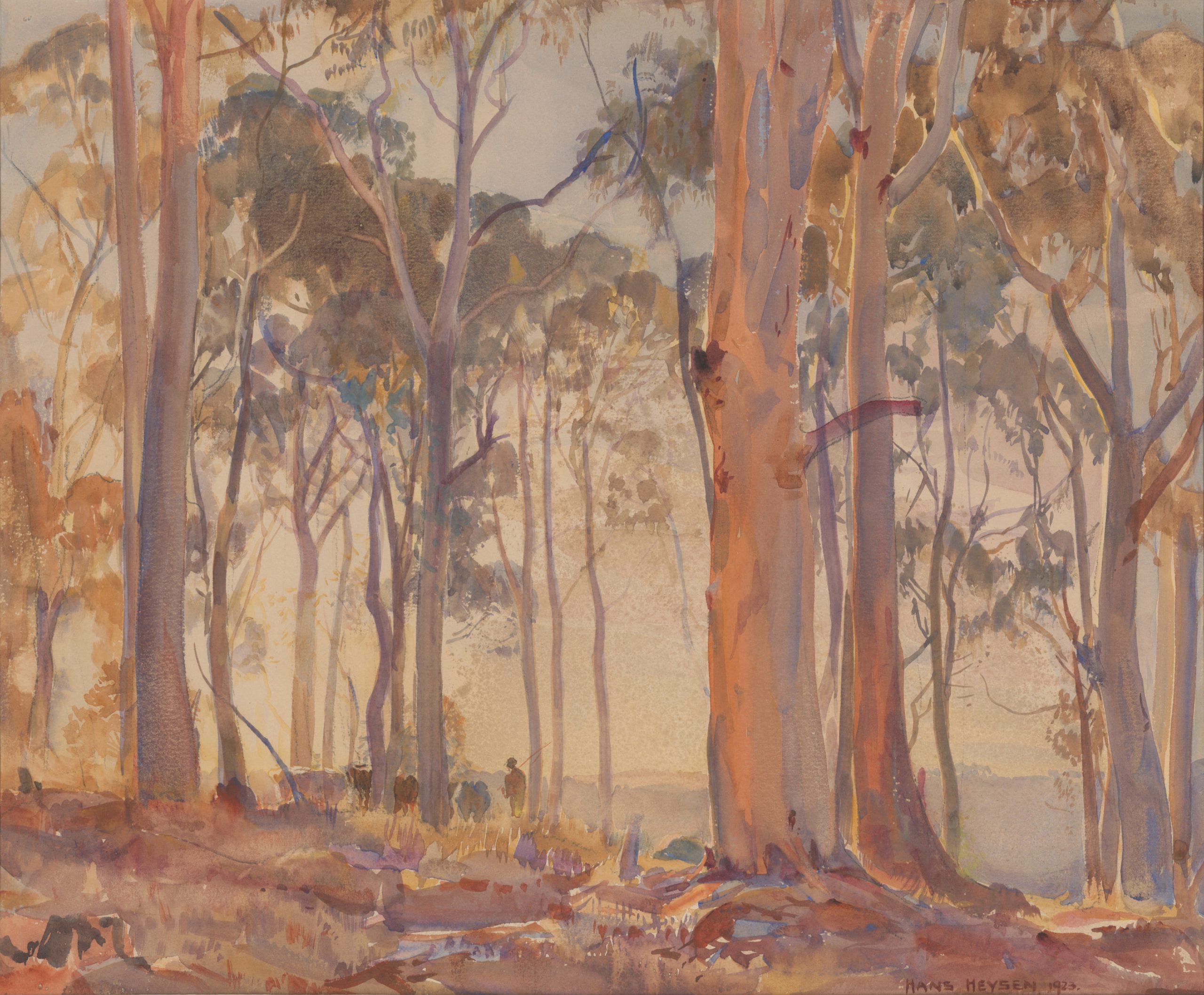17th May — 28th Jul 2024
Bennett Gallery
Drawn from the Benalla Art Gallery Collection, Light Shines, Shadow Falls presents a selection of landscapes by two of Australia’s finest watercolourists, Hans Heysen and Matthew James MacNally.
The exhibition is a celebration of both artists’ mastery in rendering the Australian countryside, and the atmospheric shifts across the day as the sun rises and sets, shining its light for shadows to fall.
About Hans Heysen
Born in Hamburg, Germany in 1877, Heysen migrated to Adelaide in 1884 with his family and began painting at age 14, later taking up formal training with James Ashton.
Following early exhibitions in Adelaide, Robert Barr Smith funded Heysen’s study at the South Australian School of Design in 1898. The following year, four Adelaide businessmen provide £400 to finance Heysen’s studies in Europe. Heysen sent them all the work he produced during his years overseas as compensation.
In Paris, Hans Heysen attended the Académie Julian and Colarossi’s Academy, and was invited to join the Ecole des Beaux Arts. He returned to Adelaide in early 1904, and established a studio in the Adelaide Steamship building, from which he sold works and taught classes.
Selma (Sally) Bartels was one of Heysen’s students, and in December 1904, the two were married. They would settle in Hahndorf in 1908.
Following a hugely successful exhibition in Melbourne in 1912, Hans Heysen was able to purchase The Cedars, an established colonial home in 36 acres (15 ha) of land just outside Hahndorf. Heysen lobbied neighbours and the local Council to preserve the great trees around Hahndorf and in 1938, increased his holding to 150 acres to support preservation efforts.
Heysen’s work enjoyed wide recognition and critical acclaim following World War I, and he was particularly noted for his landscapes and studies of eucalypts. Such was his accomplishment as a landscape painter, he was awarded the Wynne Prize nine times between 1904 and 1932. He was awarded the OBE in 1945, and was knighted in 1959.
Lady Heysen died in 1962 at the age of 83, and Sir Hans passed away in the Mount Barker Hospital on 2 July 1968. Both were buried in Hahndorf cemetery.
About Matthew James MacNally
Born in Benalla in 1874, Matthew James MacNally was a well-known watercolourist, art teacher, and critic. The only child of Irish migrants, MacNally was educated at Benalla College, and subsequently at St. Patrick’s College in Melbourne.
During his youth, MacNally intended to become an architect, however family circumstances required him to take up a career in insurance in Melbourne.
His artistic journey commenced in the mid-1890s. Following a move to Sydney, and while still working as a clerk, he became captivated by the art world and took drawing lessons with artists Hal Waugh and Hal Thorpe, also expanding his social connections to include other painters including Tom Roberts.
MacNally returned to Melbourne in 1899 and enrolled in the National Gallery of Victoria’s School of Design. He worked under Frederick McCubbin for a year, and later studied watercolour and printmaking with John Mather and etching with John Shirlow.
Family financial pressures stunted MacNally’s initial artistic foray, however after finding financial success working for a butter exporting business, he was able to purchase a studio apartment on the top floor of Oxford Chambers in Bourke Street.
MacNally balanced business commitments; a social calendar which included engagements with prominent artists, musicians, critics and connoisseurs; and his art practice, which he increasingly dedicated to the watercolour medium.
MacNally’s wartime works were mainly pastoral panoramas, with an evident influence of J.J. Hilder.
Boasting impressive knowledge about the arts, and supported by powerful friends – owing to his personable nature – MacNally was appointed as the Victorian representative on the Commonwealth Art Advisory Board in 1918. An illustrated profile in Art in Australia in the same year enhanced his profile.
MacNally joined the newly established Australian Watercolour Institute in the 1920s, and from the early 1920s to the mid-1930s MacNally held over a dozen solo shows in the eastern state capitals.
The Age engaged MacNally as their principal critic from 1924 to 1926. Here, MacNally met Margaret (Rita) McLeod, a journalist and poet. The two would marry in 1925, and move to Sydney in 1926, with MacNally often painting the Northern Beaches.
MacNally became the Daily Telegraph art reviewer in Sydney, and after striking up a friendship with W.H. Ifould OBE (then director of the Mitchell Library), MacNally received a large commission to paint many of the historic buildings in the ‘Macquarie Towns’ west of Sydney. This commission would somewhat redefine MacNally’s practice, and he went on to paint many grand Sydney houses during the Depression.
MacNally would move one more time, to Adelaide in late 1935, where he joined the Royal South Australian Society of Arts, became principal art writer for the major news publication, and lectured at the Art Gallery of South Australia. Despite remaining active in the arts community, he rarely exhibited in Adelaide during his final years.
After a long illness Matthew James MacNally died in 1943, aged 70, in his Mount Lofty home.
